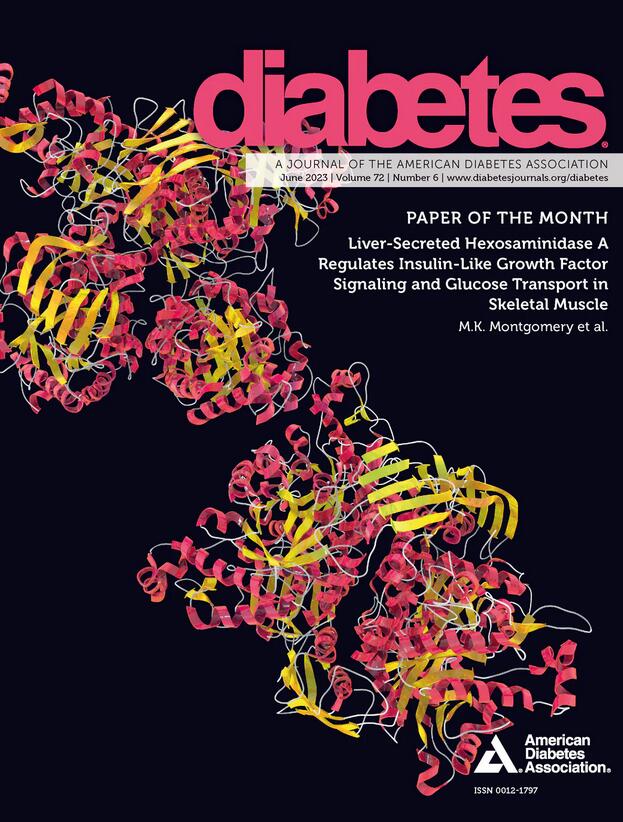2041-LB: GLP-1RA治疗期间肌少症管理的连续蛋白传感器
IF 7.5
1区 医学
Q1 ENDOCRINOLOGY & METABOLISM
引用次数: 0
摘要
简介和目的:胰高血糖素样肽-1受体激动剂(GLP-1 RAs)对肥胖和/或糖尿病患者的减肥和血糖控制非常有效,但可能导致肌肉减少症-瘦肌肉量损失(LLMM)(1)。LLMM效应(2)可以通过锻炼和增加蛋白质摄入来克服。苯丙氨酸(phe)是骨骼肌分解和外源蛋白质摄入释放的必需氨基酸。一种带有活动监测器的可穿戴苯丙氨酸传感器可以跟踪LLMM和蛋白质的摄入,用于这些变革性药物。该传感器采用了一种新的方法,该方法依赖于使用亚甲基蓝氧化还原探针标记的短核酸序列(适体)的工程phe生物受体。该适体附着在电极表面,通过电化学技术方波伏安法测量苯的结合和浓度。方法:将适体生物受体应用于微针电极,在磷酸盐缓冲液(PBS)中进行0 ~ 1500µM/L的校准。结果:phe传感器在第1天和第7天呈对数线性校准(图1),R^2 d1: 0.986, d7: 0.994,检测下限d1: 3.9µM/L, d7: 6.4µM/L。结论:这项工作证明了一种概念验证的连续蛋白监测仪的性能,该监测仪利用微传感器阵列上的工程生物受体,可以与GLP-1 RA治疗结合使用。R.戈特利布:雇员;Biolinq。B. Wang:员工;Biolinq。J.E.卡夫纳:雇员;Biolinq。K. Mallires:雇员;Biolinq。J.R. Tangney:没有。本文章由计算机程序翻译,如有差异,请以英文原文为准。
2041-LB: Continuous Protein Sensor for Sarcopenia Management during GLP-1RA Therapy
Introduction and Objective: Glucagon-like peptide-1 receptor agonists (GLP-1 RAs) are highly effective in both weight loss and glycemic control for people with Obesity and/or Diabetes but can result in sarcopenia - loss of lean muscle mass (LLMM) (1). LLMM effects (2) can be overcome through exercise and increased protein consumption. Phenylalanine (phe) is an essential amino acid released from skeletal muscle breakdown and exogenous protein ingestion. A wearable phenylalanine sensor with activity monitor could track LLMM and protein ingestion for use with these transformative medications. This sensor utilizes a new methodology that relies on an engineered phe bioreceptor using a short nucleic acid sequence (aptamer) labeled with a methylene blue redox probe. This aptamer is attached to an electrode surface where the binding and concentration of the phe is measured through the electrochemical technique square wave voltammetry. Methods: The aptamer bioreceptor was applied to microneedle electrodes and a calibration (0-1500 µM/L) was performed in phosphate buffer solution (PBS). Results: The phe sensor showed log-linear calibration on day 1 and 7 (Fig 1), R^2 d1: 0.986, d7: 0.994, with low limit of detection d1: 3.9 µM/L, d7: 6.4 µM/L. Conclusion: This work demonstrated performance of a proof-of-concept continuous protein monitor utilizing an engineered bioreceptor on a microsensor array that could be used in conjunction with GLP-1 RA therapy. Disclosure R. Gottlieb: Employee; Biolinq. B. Wang: Employee; Biolinq. J.E. Kavner: Employee; Biolinq. K. Mallires: Employee; Biolinq. J.R. Tangney: None.
求助全文
通过发布文献求助,成功后即可免费获取论文全文。
去求助
来源期刊

Diabetes
医学-内分泌学与代谢
CiteScore
12.50
自引率
2.60%
发文量
1968
审稿时长
1 months
期刊介绍:
Diabetes is a scientific journal that publishes original research exploring the physiological and pathophysiological aspects of diabetes mellitus. We encourage submissions of manuscripts pertaining to laboratory, animal, or human research, covering a wide range of topics. Our primary focus is on investigative reports investigating various aspects such as the development and progression of diabetes, along with its associated complications. We also welcome studies delving into normal and pathological pancreatic islet function and intermediary metabolism, as well as exploring the mechanisms of drug and hormone action from a pharmacological perspective. Additionally, we encourage submissions that delve into the biochemical and molecular aspects of both normal and abnormal biological processes.
However, it is important to note that we do not publish studies relating to diabetes education or the application of accepted therapeutic and diagnostic approaches to patients with diabetes mellitus. Our aim is to provide a platform for research that contributes to advancing our understanding of the underlying mechanisms and processes of diabetes.
 求助内容:
求助内容: 应助结果提醒方式:
应助结果提醒方式:


